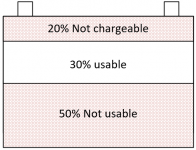Just a comment about the concept of B2B AND VSR in the one install. It works well and and be worth doing IF you have the setup that would benefit. i.e. a big bank that you take down to a fairly low SOC on a regular basis.
As an example, in my camper, sometimes when I plug in, I could be feeding the 645Ah of batteries in excess of 100A for 2 or more hours. In THAT case, a mains charger that only delivers 30A would obviously be over 3 times slower. Transfer that to when driving and if you had an alternator that could deliver 100A+ to the battery it would be much faster than if it went through a 30A B2B instead.
But few alternators can deliver close to 100A in reality (in my camper, it seems to be around 50A max). Plus few batteries (talking Lead Acid now) will take a big charge.
Phil, you talk about the 80% SOC switchover from VSR to B2B. This is something I did using a relay and control from a battery monitor. It is not something that is built into any charger. I just want to make that point as you post some fairly detailed info but didn't mention a battery monitor.
The way you would typically determine the switch over point from a VSR to a B2B is at what SOC the charge current lowers to the max output of the B2B. So you have a 30A B2B installed and a VSR. You find that when using the VSR, the current gradually drops as the batteries fill, and the current hits 30A when the SOC is say 75% (the value will vary from install to install due to different battery setups), then that 75% is around your changeover sweet spot to the B2B. If you had a 60A B2B, the changeover SOC would be lower. The sooner you switch to B2B the better the quality (voltage) of the charge. Before that point you are getting quantity (higher current). You need the charge to be at the right voltage level to complete the charging. This is why VSRs are not the best option to charge a battery as the alternator does not put out a high enough voltage to properly charge a battery (a VSR is not a battery charger, it is just an automated passthrough for the alternator).
The switchover point does also depend on the voltage output of the alternator. If it is pretty low you may need to switch to B2B earlier to get the boost. If the Voltage is around what the batteries like, then switching later is fine.
13.6V sounds remarkably low output? If it is that, then your starter battery will not be getting a decent charge to start with anyway (which could be a different issue you need to manage?) A B2B will work fine setup with the right thresholds but as you say, the VSR will not click on. A battery maintainer such as the AMT would probably be the best match for the B2B.

